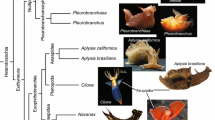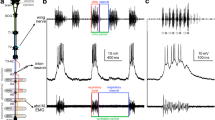Summary
This study describes the neural basis of respiratory behavior in a pulmonate mollusc, Lymnaea stagnalis. We describe and identify muscles of the respiratory orifice (pneumostome) and mantle cavity as well as relevant motor neurons innervating these muscles. All of these identified motor neurons are active during spontaneously occurring respiratory behavior and a sporadically occurring synaptic input, termed Input 3, controls the activities of these motor neurons. This spontaneous input can also be recorded from isolated brain preparations, suggesting that the respiratory motor program is generated centrally. However, evidence is also presented that in semi-intact preparations the role of peripheral feedback is important for the initiation and termination of respiratory behavior in Lymnaea.
Similar content being viewed by others
References
Alevizos A, Weiss KR, Koester J (1989) SCP-containing R20 neurons modulate respiratory pumping in Aplysia. J Neurosci 9:3058–3071
Bekius R (1972) The circulatory system of Lymnaea stagnalis (L.).Neth J Zool 22:1–58
Benjamin PR (1983) Gastropod feeding: Behavioral and neuronal analysis of a complex multicomponent system. In: Roberts A, Roberts BL (eds) Neural origin of rhythmic movements. Soc Exp Biol Symp 37:159–193
Benjamin PR, Winlow W (1981) The distribution of three wide-acting synaptic inputs to identified neurons in the isolated brain of Lymnaea stagnalis (L.). Comp Biochem Physiol 70A:293–307
Buckett KJ, Peters M, Benjamin PR (1990) Excitation and inhibition of the heart of the snail, Lymnaea by non-FMRFamidergic motoneurons. J Neurophysiol 63:1436–1447
Burrows M (1975a) Co-ordinating interneurons of the locust which convey two patterns of motor commands: Their connexions with flight motor neurons. J Exp Biol 63:713–733
Burrows M (1975b) Co-ordinating interneurons of the locust which convey two patterns of motor commands: Their connexions with ventilatory motor neurons. J Exp Biol 63:735–753
Burrows M (1982) Interneurons co-ordinating the ventilatory movements of the thoracic spiracles in the locust. J Exp Biol 97:385–400
Byrne J (1983) Identification and initial characterization of a cluster of command and pattern generating neurons underlying respiratory pumping in Aplysia californica. J Neurophysiol 49:482–508
Byrne J, Koester J (1978) Respiratory pumping: Neuronal control of a centrally command behavior in Aplysia. Brain Res 143:87–105
Delcomyn F (1980) Neural basis of rhythmic behavior in animals.Science 210:492–498
de Vlieger TA, Lever de-Vries CH, Plesch BEC (1976) Peripheral and central control of the pneumostome in Lymnaea stagnalis. In: Salanki J (ed) Neurobiology of invertebrates, Gastropoda brain, Akadémiai Kiadó, Budapest, pp 624–634
Dickinson PS, Prior DJ, Avery C (1988) The pneumostome rhythm in slugs: a response to dehydration controlled by hemolymph osmolarity and peptide hormones. Comp Biochem Physiol 89A:579–585
Feldman JL, Ellenberger HH (1988) Central coordination of respiratory and cardiovascular control in mammals. Annu Rev Physiol 50:593–606
Ferguson GP (1984) Neurophysiological analysis of whole body withdrawal in Lymnaea stagnalis. Ph.D. Dissertation, University of Sussex
Getting P (1988) Comparative analysis of invertebrate central pattern generators. In: Cohen AH, Rossignol S, Grillner S (eds) Neural control of rhythmic movements. Wiley, New York, pp 101–128
Girdlestone D, Cruickshank SGH, Winlow W (1989) A system for the application of general anaesthetics and other volatile agents to superfused, isolated tissue preparations. Comp Biochem Physiol 92C:35–37
Grillner S, Wallen P (1982) On peripheral control mechanism acting on the central pattern generators for swimming in the dogfish. J Exp Biol 98:1–22
Hening WA (1982) Central generation and coordination of a complex behavioral sequence in Aplysia californica: Locomotion and respiratory pumping. Ph.D. Dissertation, New York University
Janse C, van der Wilt CJ, van der Plas J, van der Roest M (1985) Central and peripheral neurons involved in oxygen perception in the pulmonate snail Lymnaea stagnalis (Mollusca, Gastropoda). Comp Biochem Physiol 82A:459–469
Jones HD (1961) Aspects of respiration in Planorbis corneus (L.) and Lymnaea stagnalis (L.) (Gastropoda: Pulmonata). Comp Biochem Physiol 4:1–29
Koester J (1989) Chemically and electrically coupled interneurons mediate respiratory pumping in Aplysia. J Neurophysiol 62:1113–1126
Pearson KG (1985) Are there central pattern generators for walking and flight in insects? In: Barnes WJP, Gladden MH (eds) Feedback and motor control in invertebrates and vertebrates. Croom Helm, London, pp 307–315
Pearson KG, Duysens J (1976) Function of segmental reflexes in the control of stepping in cockroaches and cats. In: Herman RM, Grillner S, Stein PSG, Stuart DG (eds) Neural control of locomotion. Plenum Press, New York, pp 519–539
Selverston AI (1980) Are central pattern generators understandable? Behav Brain Sci 3:535–571
Siller KT, Heitier WJ (1985) The neural basis of escape swimming behavior in the squat lobster Galathea strigosa. II. Mechanism of burst production. J Exp Biol 117:291–300
Slade CT, Mills J, Winlow W (1981) The neuronal organization of the paired pedal ganglia of Lymnaea stagnalis (L.). Comp Biochem Physiol 69A:789–803
Stehouwer DJ, Farel PB (1980) Central and peripheral controls of swimming in anuran larvae. Brain Res 195:323–335
Syed NI (1988) Neural control of locomotion in Lymnaea. Ph.D. Dissertation, University of Leeds, U.K.
Syed NI, Winlow W (1989) Morphology and electrophysiology of neurons innervating the ciliated locomotor epithelium of Lymnaea stagnalis (L.). Comp Biochem Physiol 93A:633–644
Syed NI, Bulloch AGM, Lukowiak K (1990) In vitro reconstruction of the respiratory central pattern generator of the mollusk Lymnaea. Science 250:282–285
Syed NI, Winlow W (1991) Respiratory behavior in the pond snail Lymnaea stagnalis II. Neural elements of the central pattern generator (CPG). J Comp Physiol 169:557–568
van der Wilt CJ, van der Roest M, Janse C (1987) Neuronal substrates of respiratory behavior and related functions in Lymnaea stagnalis. In: Boer HH, Geraerts WPM, Joosse J (eds) Neurobiology, molluscan models. North Holland, Amsterdam, pp 282–290
van der Wilt CJ, van der Roest M, Janse C (1988) The role of two peptidergic neurons in modulation of respiratory behavior in the pond snail Lymnaea stagnalis. Symp Biol Hung 26:377–386
von Euler C (1985) Central pattern generation during breathing. In: Evarts EV, Wise SP, David B (eds) The motor system in neurobiology. Elsevier Biomedical Press, Amsterdam, pp 47–51
Wendler G (1983) The locust flight system: functional aspects of sensory input and methods of innervation. In: Gustav Fischer (ed) Nachtigall W Biona Report 2, Stuttgart, pp 113–125
Willows AOD, Dorsett DA, Hoyle G (1973) The neuronal basis of behavior in Tritonia. I. Functional organization of the central nervous system. J Neurobiol 4:207–237
Winlow W, Benjamin PR (1976) Neuronal mapping of the brain of the pond snail, Lymnaea stagnalis (L.) In: Salanki J (ed) Neurobiology of invertebrates, Gastropoda brain. Akadémiai Kiadó, Budapest, pp 41–59
Winlow W, Haydon PG, Benjamin PR (1981) Multiple postsynaptic actions of the giant dopamine-containing neuron R.Pe.D.1 of Lymnaea stagnalis. J Exp Biol 94:137–148
Author information
Authors and Affiliations
Rights and permissions
About this article
Cite this article
Syed, N.I., Harrison, D. & Winlow, W. Respiratory behavior in the pond snail Lymnaea stagnalis . J Comp Physiol A 169, 541–555 (1991). https://doi.org/10.1007/BF00193545
Accepted:
Issue Date:
DOI: https://doi.org/10.1007/BF00193545




